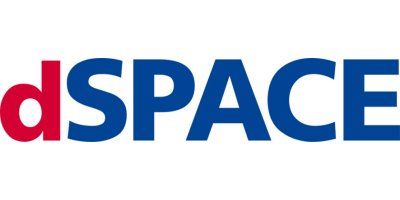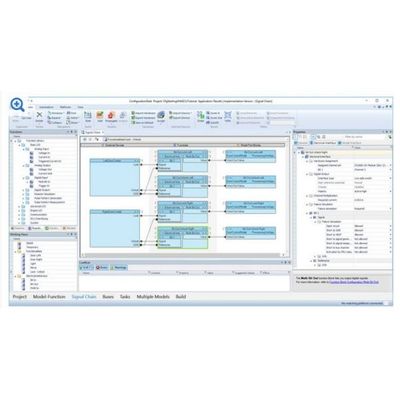

- Home
- Companies
- dSPACE GmbH
- Software
- dSPACE - Version ConfigurationDesk - ...

dSPACE - Model ConfigurationDesk - Configuration and Implementation Software
ConfigurationDesk is an intuitive, graphical configuration and implementation tool, ideal for handling applications from small Rapid Control Prototyping (RCP) developments to large hardware-in-the-loop (HIL) tests based on dSPACE real-time hardware, such as SCALEXIO or MicroAutoBox III, including the implementation of behavior models and I/O function code. ConfigurationDesk provides a clearly structured overview of the external devices (e.g., ECUs), configured real-time hardware, and the connected behavior models.
- General :
- Graphical configuration of real-time applications
- Decoupling of I/O configuration and behavior model
- Integration of models from various tools
- Enhanced graphical user guidance through the workflow of the configuration
- Supported platforms :
- SCALEXIO systems
- MABX III
- Interactive Simulink support :
- Generation of ConfigurationDesk projects directly from the Simulink model
- Switch from Simulink to ConfigurationDesk and vice versa in only one click
- The interface of Simulink models can be changed/adapted on both sides, in Simulink and in ConfigurationDesk. The changes can be propagated to the opposite side
- Start the overall build process from the Simulink model
- Support of various model container formats :
- Simulink implementation container (SIC)
- Simulink implementation containers can be imported and compiled without requiring a MATLAB/Simulink installation (reuse for different projects or variants without having to generate the model code again).
- Functional Mock-up Unit (FMU)
- Bus simulation container (BSC):
- IP protection of the model through compiled model containers without source code
- TargetLink support : Simulation of TargetLink-generated code as V-ECUs, FMUs, or SIC files
- AUTOSAR support : Simulation of V-ECUs generated by SystemDesk or TargetLink
- I/O configuration and documentation :
- For the graphical definition of the complete signal chain, the model ports have to be mapped to the I/O of the real-time hardware. ConfigurationDesk offers the following configuration features:
- I/O functions (defining and configuring the functionality of the assigned real-time hardware)
- Model port mapping (connecting I/O function ports and model ports)
- Model topology (describing model ports provided by all imported behavior models)
- Hardware resource assignment (mapping I/O functions to hardware resources)
- For documentation purposes, these features allow for handling an external device:
- External device topologies (properties of ECU, plant, and load pins)
- Device port mapping (connections between the ECU, plant, and load pins and the signal ports of an I/O function)
- Export and import as Microsoft® Excel® file with pin information for external wiring harnesses
- Microsoft® Excel® file with pin information for external wiring harnesses
- Bus simulation : Support of configuring and implementing CAN, LIN, Ethernet, and FlexRay
- Real-time code generation : Complete and automatic build process of all components of your real-time application
Working with ConfigurationDesk offers a wide range of benefits when developing and testing controllers or ECUs:
- Managing the complete signal path from external device to model interface gives you a clean and clear overview of the entire application.
- Separating the behavior model from I/O configuration lets you flexibly reuse application artifacts with high flexibility.
- Simulating I/O with fixed values allows for testing even if the real I/O is not available yet.
- The automatic implementation of your application on dSPACE real-time hardware covers behavior model code, I/O function code, and all relevant application-specific code.
- An intuitive graphical display with views tailored to various use cases guides you through the RCP and HIL workflows.
- A powerful application programming interface (API) lets you automate your workflows.
- Various model and container formats, including Simulink and FMU support, each supported in source code or binary form, allow for timesaving modular and distributed development and collaborative work, including IP protection scenarios.
- The use of multiple models per application lets you build large, modular applications – an essential feature especially in the context of continuous integration.
- The same model container support as in dSPACE VEOS provides a smooth transition from SIL tests to HIL tests and vice versa.
- Comprehensive documentation options ensure traceability throughout the entire project.
With ConfigurationDesk, you can easily implement powerful real-time applications for HIL or RCP scenarios. It allows for connecting Simulink® models, Functional Mock-up Units (FMU/FMI), or virtual ECU behavior models to I/O functions or bus simulation containers (BSCs), configuring the SCALEXIO hardware or MicroAutoBox III, and controlling the entire process for the generation of real-time code. You can optionally define and document external devices, such as ECUs, electrical devices, and loads, including their signal properties (descriptions, electrical properties, failure simulation settings, and the capacity of electric loads). With this input, ConfigurationDesk generates real-time applications that will be executed on the real-time systems.
